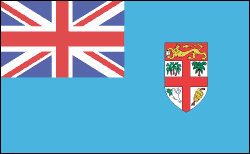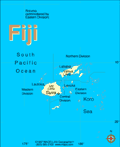Fiji | Facts & Information

- Fiji Profile
- History
- News and Current Events
Infoplease has everything you need to know about Fiji. Check out our country profile, full of essential information about Fiji's geography, history, government, economy, population, culture, religion and languages. If that's not enough, click over to our collection of world maps and flags.
Facts & Figures
-
President: Ratu Wiliame Katonivere (2021)
Prime Minister: Voreqe "Frank" Bainimarama (2014)
Total area: 7,054 sq mi (18,270 sq km)
Population (2022 est.): 943,737 (growth rate: .44%); birth rate: 16.56/1000; infant mortality rate: 10.06/1000; life expectancy: 74.27
Capital and largest city (2018 est.): Suva (on Viti Levu), 178,000
Monetary unit: Fiji dollar
Languages: English (official), Fijian (official), Hindustani
Ethnicity/race: iTaukei 56.8% (predominantly Melanesian with a Polynesian admixture), Indian 37.5%, Rotuman 1.2%, other 4.5% (European, part European, other Pacific Islanders, Chinese)
note: a 2010 law replaces 'Fijian' with 'iTuakei' when referring to the original and native settlers of Fiji (2007 est.)Religions: Protestant 45% (Methodist 34.6%, Assembly of God 5.7%, Seventh Day Adventist 3.9%, and Anglican 0.8%), Hindu 27.9%, other Christian 10.4%, Roman Catholic 9.1%, Muslim 6.3%, Sikh 0.3%, other 0.3%, none 0.8% (2007 est.)
National Holiday: Independence Day, 2nd Monday of October
Literacy rate: 99.1% (2018 est.)
Economic summary: GDP/PPP (2020 est.): $9.86 billion; per capita $11,000. Real growth rate: 3%. Inflation: 3.4%. Unemployment: 4.5%. Arable land: 9%. Agriculture: sugarcane, coconuts, cassava (tapioca), rice, sweet potatoes, bananas; cattle, pigs, horses, goats; fish. Labor force: 353,100; agriculture 44.2%, industry 14.3%, services 41.6%. Industries: tourism, sugar, clothing, copra, gold, silver, lumber, small cottage industries. Natural resources: timber, fish, gold, copper, offshore oil potential, hydropower. Exports: $1.23 billion (2020): sugar, garments, gold, timber, fish, molasses, coconut oil. Major trading partners (exports): United States 29%, Australia 14%, New Zealand 7%, Japan 6%, Tonga 6% (2019). Imports: $1.97 billion (2020): manufactured goods, machinery and transport equipment, petroleum products, food, chemicals. Major trading partners (imports): Singapore 18%, Australia 13%, China 13.8%, New Zealand 11%, France 11%, South Korea 8% (2017).
Communications: Telephones: main lines in use: 48,51 (2020); mobile cellular: 991,500. Broadcast media: Fiji TV, a publicly traded company, operates a free-to-air channel as well as Sky Fiji and Sky Pacific multi-channel pay-TV services; state-owned commercial company, Fiji Broadcasting Corporation, Ltd, operates 6 radio stations - 2 public broadcasters and 4 commercial broadcasters with multiple repeaters; 5 radio stations with repeaters operated by Communications Fiji, Ltd; transmissions of multiple international broadcasters are available (2020). Internet hosts: 21,739 (2012). Internet users: 444,978 (2019).
Transportation: Railways: total: 597 km; note: belongs to the government-owned Fiji Sugar (2008). Highways: total: 3,440 km; paved: 1,692 km; unpaved: 1,748 km (2011 est.). Waterways: 203 km; 122 km navigable by motorized craft and 200-metric-ton barges (2012). Ports and harbors: Lambasa, Lautoka, Suva. Airports: 28 (2021).
International disputes: none.









